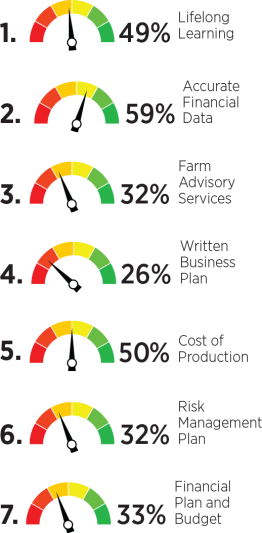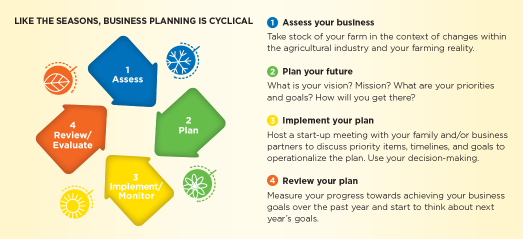7 practices to improve farm management
Farm Management Canada has found seven management practices that differentiate top farm business performers from the rest of the pack. The difference often comes down to action: Top farms do these things. Others don’t.
“Farm business management means taking a proactive approach to build the underlying capacity to weather any storm and seize opportunity, positioning the farm for continued success,” says Heather Watson, executive director of Farm Management Canada (FMC). “It really boils down to having accurate, reliable data to create a realistic picture of what’s possible and a plan to guide you towards success.”
FMC together with the Agri-Food Management Institute and Ipsos Agriculture and Animal Health conducted phone interviews with over 600 farmers across Canada and asked them to rate their own adoption of seven different management practices.
The 7 practices: Survey results
1. Lifelong learning. FMC’s results concluded 49 per cent of farmers were committed to continual lifelong learning. “Whether it’s attending a conference, workshops, tuning into webinars, or reading books, it’s important to continue to expand your knowledge base in order to make informed business decisions that respond to an ever-changing industry,” says Watson. “Take the time to create a skills development plan as part of the farm business plan. Create a culture of lifelong learning.”
At a glance
7 management practices for top farms and the percentage of farmers that apply them.

2. Accurate financial data. Business decisions made using accurate financial data scored a 59 per cent adoption rate. While many factors influence decision-making on the farm, Watson says having access to accurate financial data is essential.
“And preferably, financial data that lets you analyze financial trends (past) and what-if scenarios (future) for your farm, so you can plan for what may happen going forward.”
3. Farm advisory services. Only 32 per cent of respondents replied they sought the help of business advisors/consultants. “There’s a saying we use in business: do your best, hire the rest,” says Watson. “Farm business advisors play a major role when it comes to business growth and especially farm transition planning, helping facilitate the necessary conversations between generations of farm managers for continued success and prosperity.”
4. Written business plan. The worst score came for farmers creating a written business plan that they follow and review annually with only 26 per cent adopting this practice. “Too often we hear there is a plan, but it is not written down,” Watson says. “We tend to say, ‘If it isn’t written, it’s not real.’ Writing the plan down facilitates important conversations about the future of the farm and everyone’s role within it.”
A plan should start with a vision, mission and value statements, and detail the activities and resources required, including people, money and infrastructure to reach desired goals. The planning process should involve consultation with key stakeholders including family members, business partners, and farm business advisors, Watson says.
She suggests farmers annually review what’s working and what isn’t. “While farming is a business riddled with uncertainty, the plan provides certainty,” says Watson. “By taking the time to outline where you want the business to go, when risk or opportunity arises, the plan provides a reference point to consider the implications of your decision.”
5. Cost of production. Adoption rates for farmers knowing and monitoring their costs of production and what it means for their profits were higher, at 50 per cent. “Your balance sheet and financial statements may tell you how the farm is doing overall, but you may be investing in farm activities that are losing you money,” says Watson. Also helpful can be benchmarking – comparing your costs year to year and to those of similar operations – in order to determine areas of potential improvement.
6. Risk management plan. Only 32 per cent of respondents admitted assessing risks and having a plan to manage and mitigate risks. “For many farmers, risk management is mistakenly synonymous with and limited to public farm support and insurance programs,” says Watson. Farmers who actively manage their risks proactively identify what is and isn’t in their control, and establish measures that minimize possible threats while maximizing the potential rewards of taking calculated risks, she explains. “With a better understanding of risk, you’re are more likely to take the right risks, mitigate the bad, and continue to profit,” Watson says.
7. Financial plan and budget. FMC reported similar low adoption rates – 33 per cent – for farmers using budget and financial plans to monitor their positions and options. “To be profitable, farmers must also be financially resilient. This means thinking about the scenarios that could affect the profitability of the farm and putting a plan in place to best manage uncertainty,” Watson says. “Cash still reigns supreme when it comes to having the means to weather any storm or seize opportunity.”
Business management
is worth the time
“In an ever-changing industry riddled with uncertainty, wouldn’t you want to do everything in your power to come out on top?”
Farmers might struggle to find the time to do these seven practices, but Watson sees huge potential in making the effort.
“We have done this well so far. Imagine what Canadian farms can achieve by applying these tried and true practices,” she says. “In an ever-changing industry riddled with uncertainty, wouldn’t you want to do everything in your power to come out on top?”
The numbers bear out the financial rewards of higher adoption rates. “Investing in farm business management practices can increase your profitability by up to 525 per cent, taking the farm from a vulnerable to a strong financial position to confront change with confidence, take calculated risks to seize opportunity and thrive.”






